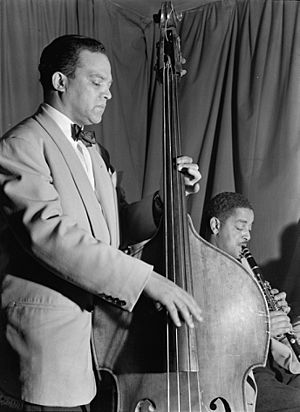Buster Bailey facts for kids
Quick facts for kids
Buster Bailey
|
|
|---|---|

John Kirby (standing) and Buster Bailey (seated), Washington D.C., c. May 1946
Photography by William P. Gottlieb |
|
| Background information | |
| Birth name | William C. Bailey |
| Born | July 19, 1902 Memphis, Tennessee, U.S. |
| Died | August 12, 1967 (aged 65) New York City, U.S. |
| Genres | Jazz, swing |
| Occupation(s) | Musician |
| Instruments | Clarinet |
| Years active | 1917–1967 |
| Associated acts | Fletcher Henderson, John Kirby, Red Allen |
William C. "Buster" Bailey (born July 19, 1902 – died April 12, 1967) was a famous American jazz musician. He was best known for playing the clarinet, a type of woodwind instrument. Buster Bailey played with many of the biggest names in jazz, like Louis Armstrong and Fletcher Henderson. He helped shape the sound of jazz music for over 50 years.
Contents
Buster Bailey's Music Journey
Starting Out Young
Buster Bailey learned to play the clarinet from Franz Schoepp. This was a classical music teacher who also taught another famous clarinet player, Benny Goodman.
Buster started his music career very young. In 1917, when he was just 15 years old, he joined W.C. Handy's Orchestra. He toured with Handy's band for two years.
In 1919, Bailey joined Erskine Tate's Vendome Orchestra. He stayed with Tate until 1923. Then, he joined Joe "King" Oliver's band. While playing with King Oliver's Creole Jazz Band, Bailey became good friends with Louis Armstrong. Armstrong was also a member of the band at that time.
Moving to New York
In 1924, Louis Armstrong left King Oliver's band. He moved to New York to join Fletcher Henderson's Orchestra. Just a month later, Armstrong invited Buster Bailey to join him in Henderson's band. Bailey accepted and moved to New York City.
During the late 1920s in New York, Buster Bailey became a very respected musician. He was a "sideman," meaning he played with many different bands and artists. He appeared on many recordings, playing both the clarinet and the soprano saxophone. He also played on several recordings for Clarence Williams.
In 1927, Bailey left Fletcher Henderson's band. He went on a tour of Europe with Noble Sissle's Orchestra. After returning, Bailey played with other jazz musicians like Edgar Hayes. He rejoined Sissle's orchestra in 1931 and stayed with them until 1933.
Playing with John Kirby
In 1934, Bailey briefly returned to Fletcher Henderson's band. But by the end of that year, he joined the John Kirby Band. Bailey was a member of Kirby's band until 1946. Even while with Kirby, he still played with other artists. For example, he played with the Mills Blue Rhythm Band in 1934 and 1935. He also recorded music under his own name, as Buster Bailey and His Rhythm Busters.
Later Years in Music
In 1946, Buster Bailey started his own band. However, his group only lasted for one year. In 1947, he joined Wilbur de Paris and played with him until 1949.
In the early 1950s, Bailey played with Big Chief Russell Moore. For most of that decade, he played with Henry "Red" Allen. From 1961 to 1963, he performed with Wild Bill Davison.
Bailey was with a group called the Saints And Sinners from 1963 to 1964. In 1965, he rejoined his old friend Louis Armstrong. He became a member of Louis Armstrong and His All-Stars.
Buster Bailey passed away in April 1967 from a heart attack. He was living in Brooklyn, New York, at the time.
Buster Bailey on Screen
Buster Bailey appeared in films and on TV shows during his career.
- In 1933, he was in a film called That's the Spirit. He played himself as a band member.
- In 1947, he was an uncredited clarinet player in Sepia Cinderella. He was part of the John Kirby Sextet in that movie.
- His last film appearance was with Louis Armstrong in When the Boys Meet the Girls (1965). Again, he played a musician.
- He also appeared on TV. In 1958, he was on the DuMont TV series Jazz Party.
- In 1961, he was on The DuPont Show of the Week. He appeared in an episode called "America's Music - Chicago and All That Jazz."
Discography
Buster Bailey recorded many albums throughout his career, both as a band leader and as a sideman for other famous musicians.
As leader
- All About Memphis (1958)
- 1925–1940 (Classics)
As sideman
He played on albums for many artists, including:
- Red Allen
- Mildred Bailey
- Eubie Blake
- Wild Bill Davison
- Vic Dickenson
- Bobby Donaldson
- Leonard Gaskin
- Ronnie Gilbert
- Jackie Gleason
- Juanita Hall
- Fletcher Henderson
- Claude Hopkins
- Alberta Hunter
- Henry Jerome
- Odetta
- Jimmy Rushing
- Clarence Williams
See also
 In Spanish: Buster Bailey para niños
In Spanish: Buster Bailey para niños

